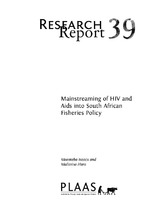| dc.contributor.author | Isaacs, Moenieba | |
| dc.contributor.author | Hara, Mafaniso | |
| dc.date.accessioned | 2019-03-11T11:04:58Z | |
| dc.date.available | 2019-03-11T11:04:58Z | |
| dc.date.issued | 2008 | |
| dc.identifier.citation | Isaacs, M. et al. (2008). Mainstreaming of HIV and Aids into South African Fisheries Policy. Research Report 39. Institute for Poverty, Land and Agrarian Studies, University of the Western Cape | en_US |
| dc.identifier.uri | http://hdl.handle.net/10566/4482 | |
| dc.description.abstract | HIV/Aids is one of the most serious health,
economic and social issues facing southern Africa
today (UNAIDS; Heywood 2004). Although only
10% of the world’s population lives in Sub-Saharan
Africa, 64% of the 39.5 million people estimated
to have been living with the HI virus in 2006 were
from Sub-Saharan Africa. Estimates show that
women are disproportionally affected, with 77%
of all women living with the virus worldwide
being from Sub-Saharan Africa. The severity of
the epidemic in southern Africa is closely linked
to poverty, the low status of women and other
Figure 2: HIV prevalence by age group, South
Africa 2005i
Figure 3: HIV prevalence in population (aged two years and older) by
race, South Africa 2005 ii
social-economic factors (Department of Health
2007). | en_US |
| dc.language.iso | en | en_US |
| dc.publisher | Institute for Poverty, Land and Agrarian Studies, University of the Western Cape | en_US |
| dc.relation.ispartofseries | Research Report;39 | |
| dc.subject | HIV | en_US |
| dc.subject | South African | en_US |
| dc.subject | Fisheries Policy | en_US |
| dc.subject | Fishing communities | en_US |
| dc.subject | High-risk factors | en_US |
| dc.title | Mainstreaming of HIV and Aids into South African fisheries policy | en_US |
| dc.type | Other | en_US |

